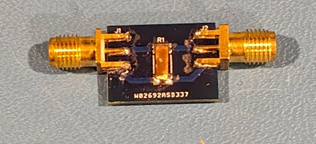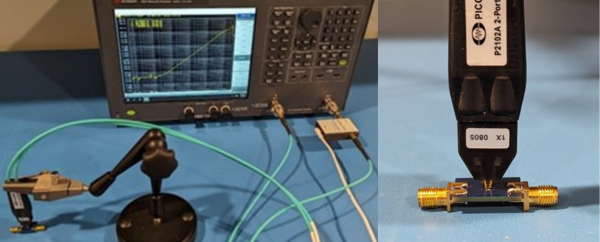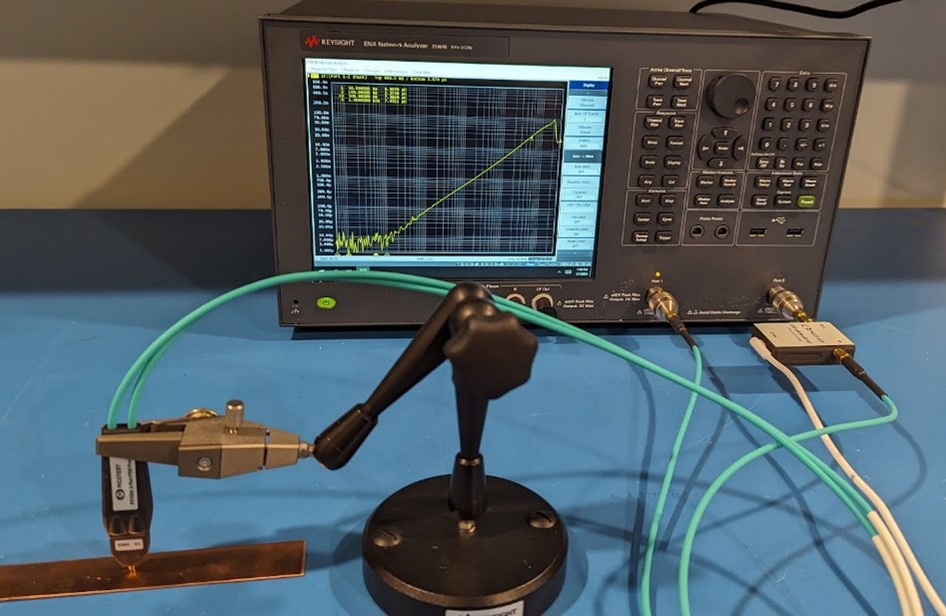This blog is part three of a three-part series. Please find part one and part two of the series here.
Recap on Measuring the Known DUT
Continuing our discussion from the last two blogs, we discussed how much CMRR is required to make this measurement, and we demonstrated this measurement with a Bode 100 VNA. To recap, before making a 40 µΩ measurement, we had to create our DUT. Figure 1 depicts the DUT that was created to support this low-impedance measurement with the 2-port probe.
 Figure 1. Depiction of 37 µΩ known DUT.
Figure 1. Depiction of 37 µΩ known DUT.However, when this DUT was made, it was not known precisely what the impedance of the copper on this PCB mount was. So, we measured it using the setup shown in Figure 2.
As shown in Figure 2, an accurate power supply is used to source 1 Amp through one cable connected to the P2102A 2-port probe, which is connected to the DUT. Where the voltage drop across the DUT is measured through the other port on the P2102A 2-port probe, which is connected by another cable and to a 6.5-digit digital multimeter (DMM). The voltage produced by a 1 Amp current is equal to the resistance, which at 25C is 37 µΩ.
Before we measure our DUT with the VNA, we will need to make a second measurement of a short with a resistance that is much lower than our DUT, this is because the Bode 100 does not have a KNOWN SHORT calibration, and we do not have known DUT beyond DC. So, Figure 3 depicts the same measurement with the power supply and DMM except the probe is contacting a pure solid, copper anode bar, which shows a value of 3.1 µΩ.
 Figure 2. Measurement result with power supply, DMM, P2102A, and DUT.
Figure 2. Measurement result with power supply, DMM, P2102A, and DUT. Figure 3. Measurement result with power supply, DMM, P2102A, and copper bar.
Figure 3. Measurement result with power supply, DMM, P2102A, and copper bar.The 40 µΩ (2000 A) PDN Measurement Result With Another VNA
Now that we have recapped on how we created a baseline measurement of our DUT’s value, we are ready to plug our VNA and connect our 2-port probe and isolator to measure the impedance. Figure 4 and Figure 5 depict our measurement setup using the E5061B, P2102A, and J2114A prototype isolator to measure our DUT and a copper bar.
 Figure 4. Measurement setup with Keysight E5061B, P2102A 2-port Probe, J2114A Prototype Isolator, and known DUT.
Figure 4. Measurement setup with Keysight E5061B, P2102A 2-port Probe, J2114A Prototype Isolator, and known DUT.  Figure 5. Measurement setup with Bode 100, P2102A 2-port Probe, J2114A Prototype Isolator, and copper bar.
Figure 5. Measurement setup with Bode 100, P2102A 2-port Probe, J2114A Prototype Isolator, and copper bar.Using EQ(1), an expression can be created within the Bode 100 to plot the impedance of our DUT.
ZDUT = DUTmeasurement - SHORTmeasurement (1)
The impedance of our DUT is plotted from the expression, shown in EQ(1), using the E6051B 100 VNA, P2102A, and the J2114A prototype isolator is shown in Figure 6 as 35.5 µΩ at 50 Hz and 31.5 µΩ at 100 Hz.
If you recall, we measured the copper bar, which is our short, to be 3.1 µΩ using the power supply and the DMM. When we subtract that value from 37 µΩ, we also measured with the power supply and DMM; this equates to a value of 33.9 µΩ, which is less than 1.7 µΩ (4.9%) difference from the result shown in Figure 6 at 50 Hz. This measurement can be challenging considering that the contact pressure from the probe and the spring contact resistance of the P2102A probe can all affect this measurement. This is one reason why a probe holder is used to maintain constant pressure. The only downside of this method with the Keysight E5061B is that you cannot export the Touchstone model (SnP) data. You can export a CSV file of the but this still needs an extra step to format the data into a Touchstone format. This means Keysight will need to update the software on this VNA or provide support for another means to be able to export this data from this measurement method.
 Figure 6. Measurement result of 37 µΩ DUT impedance measurement.
Figure 6. Measurement result of 37 µΩ DUT impedance measurement.Table 1 below summarizes the results from previous measurement setup with the Bode 100, captured in the previous blog, as well as the results with the E5061B measurement setup.
Impedance Measurement Results | Impedance Measurement Results | |
Measurement Setup | 50 Hz | 100 Hz |
Bode 100, P2102A, J2114A | 34.215 µΩ | 33.605 µΩ |
E5061B, P2102A, J2114A | 35.568 µΩ | 31.511 µΩ |
Magnitude of Delta | 1.353 µΩ | 2.094 µΩ |
Table 1. Impedance measurement result summary of 37 µΩ DUT with two VNA measurements setups.
Wrapping Up
In this three-part blog, we showed two key points:
- How to calculate the minimum CMRR with a PDN impedance measurement using a 2-port probe.
- It is possible to measure a sub-40 µΩ impedance using a 2-port probe when using an isolator that has sufficient CMRR using two different VNAs, the Bode 100 and E5061B.
Achieving sub-40 µΩ impedance measurements is challenging but completely possible and realistic with the proper test equipment.
REFERENCES
- Pure Copper Anode Sheet, Amazon.
- S. M. Sandler, “How to Measure Ultra-Low Impedance (100uOhm and Lower) PDNs,” EDI CON, October 2018.
- A. K. Davis, S. M. Sandler, “The 2-Port Shunt-Thru Measurement and the Inherent Ground Loop,” EDI CON, October 2018.
- E5061B VNA, Keysight.
- Bode 100 Vector Network Analyzer, Picotest.
- P2102A 2-Port Probe, Picotest.
- PDN Cable, Picotest.
- J2113A Semi-Floating Differential Amplifier, Picotest.




